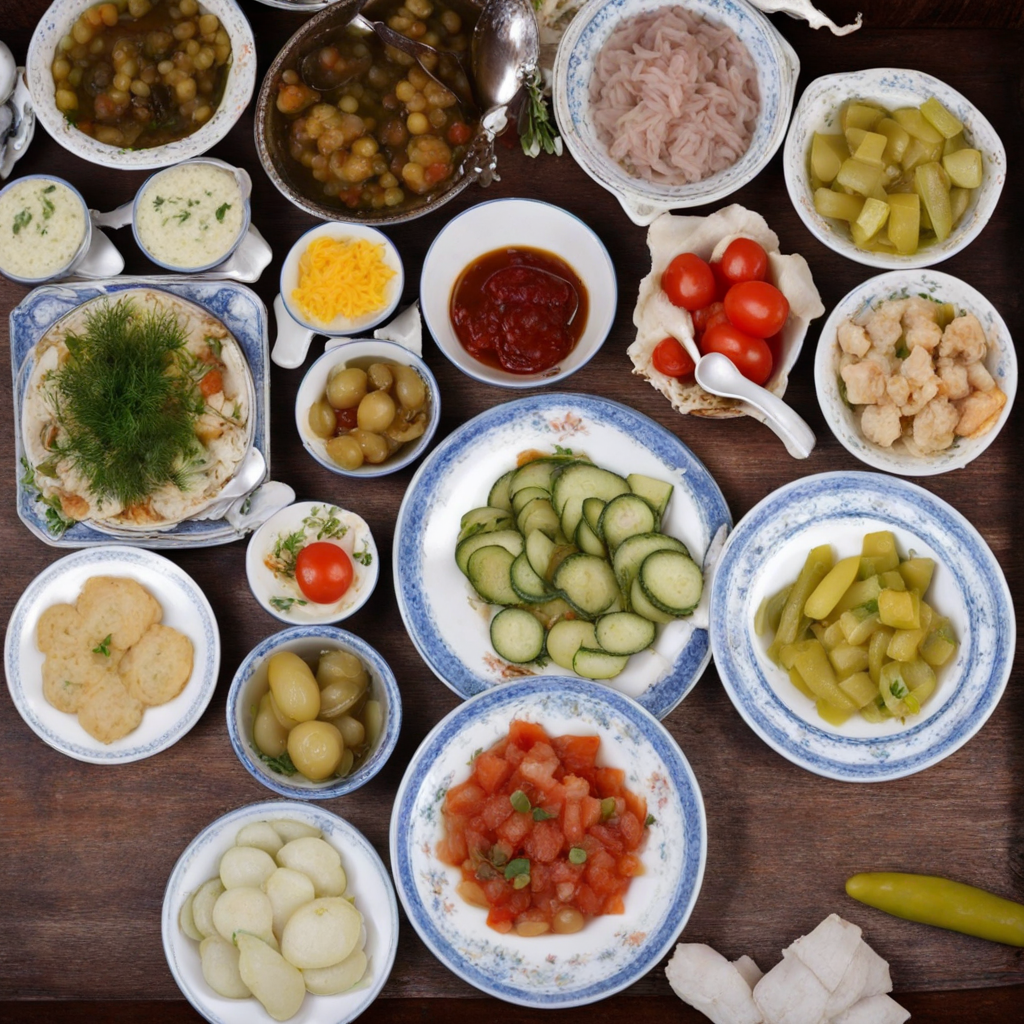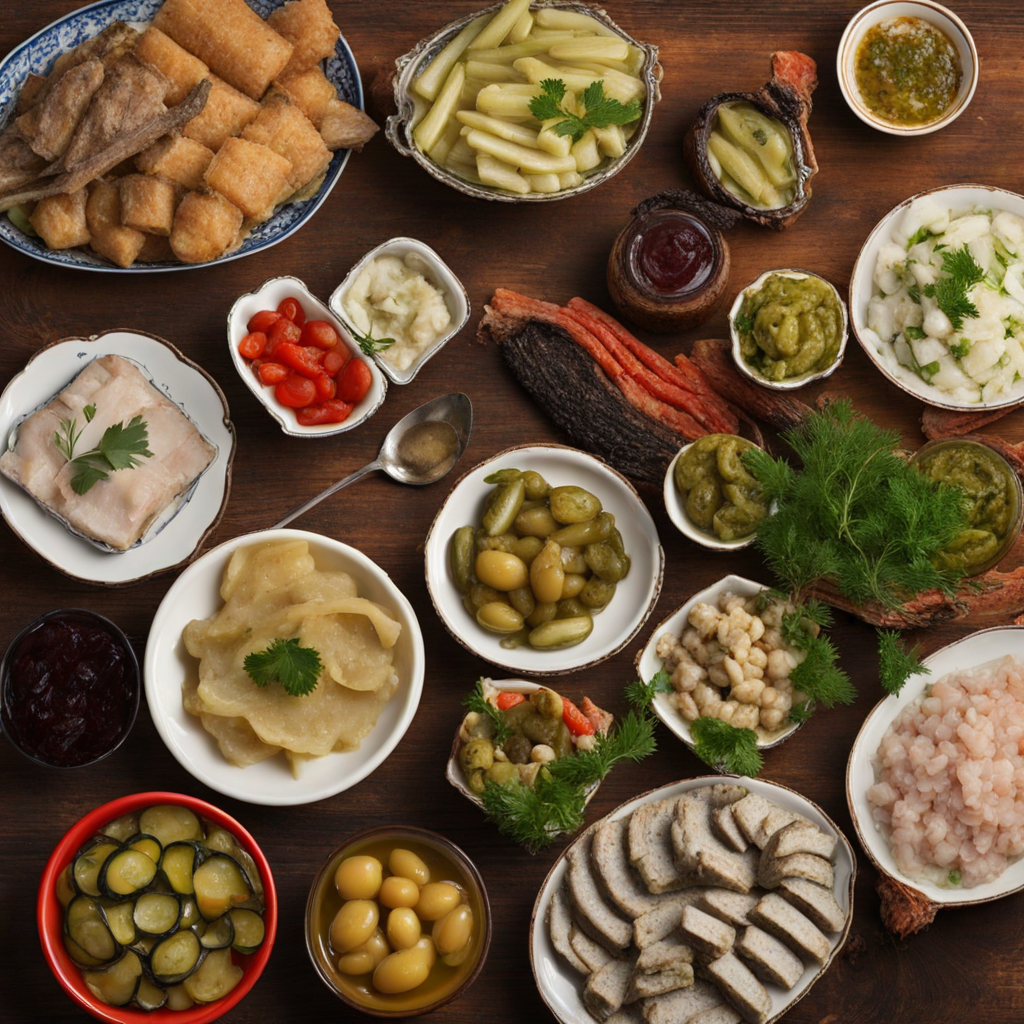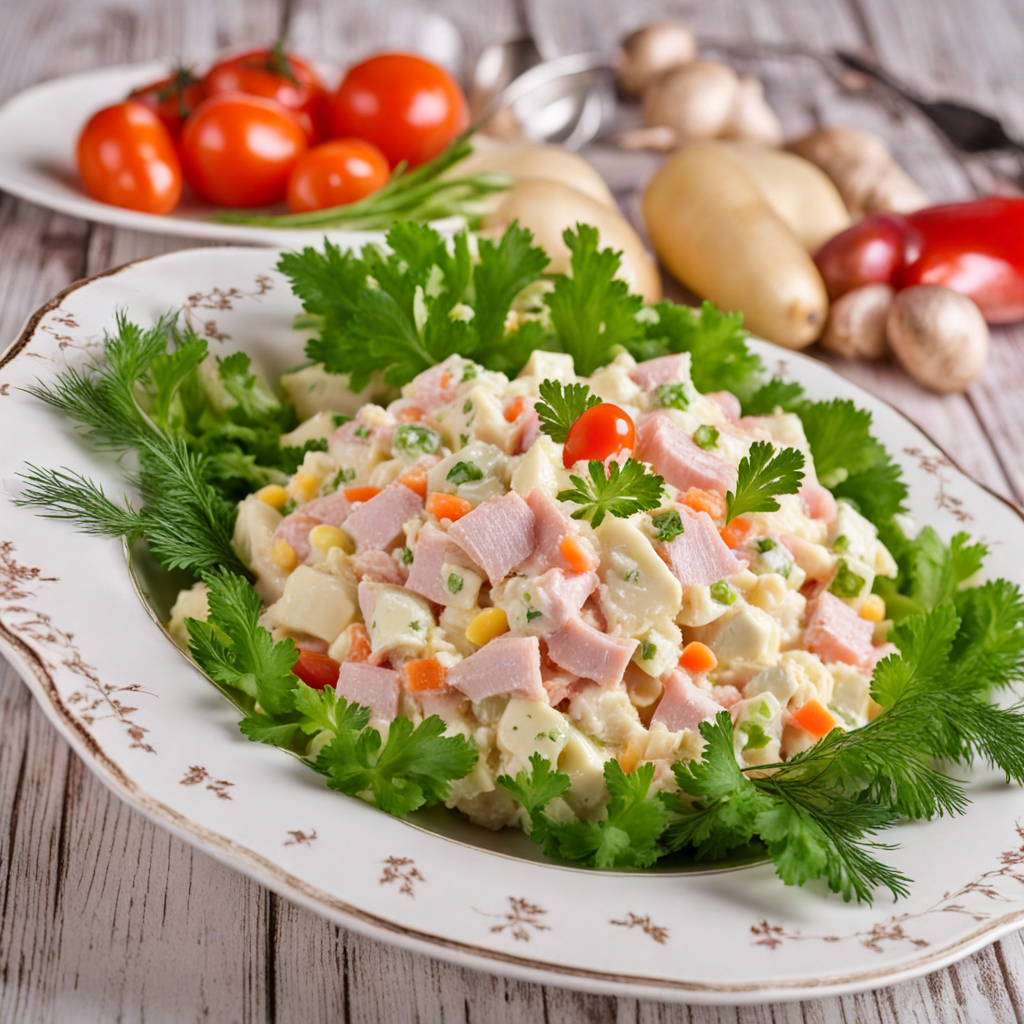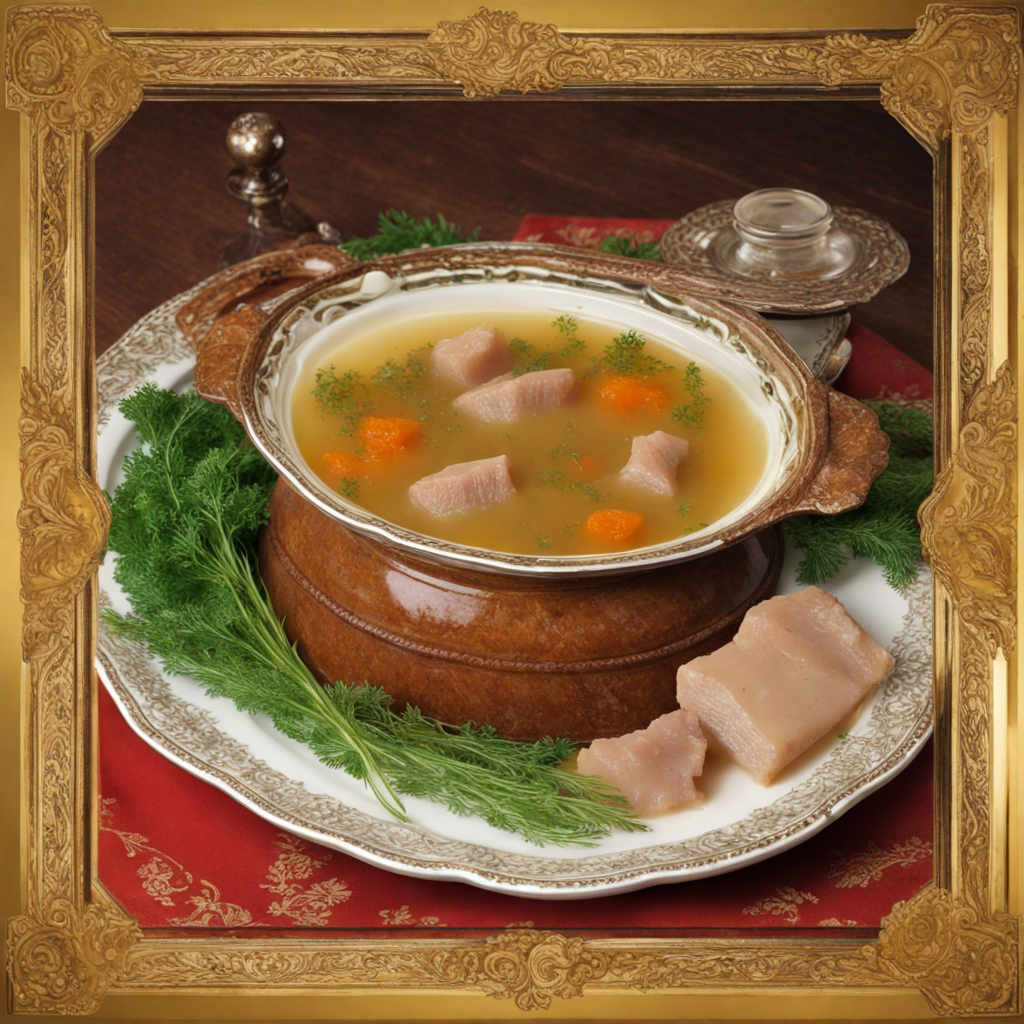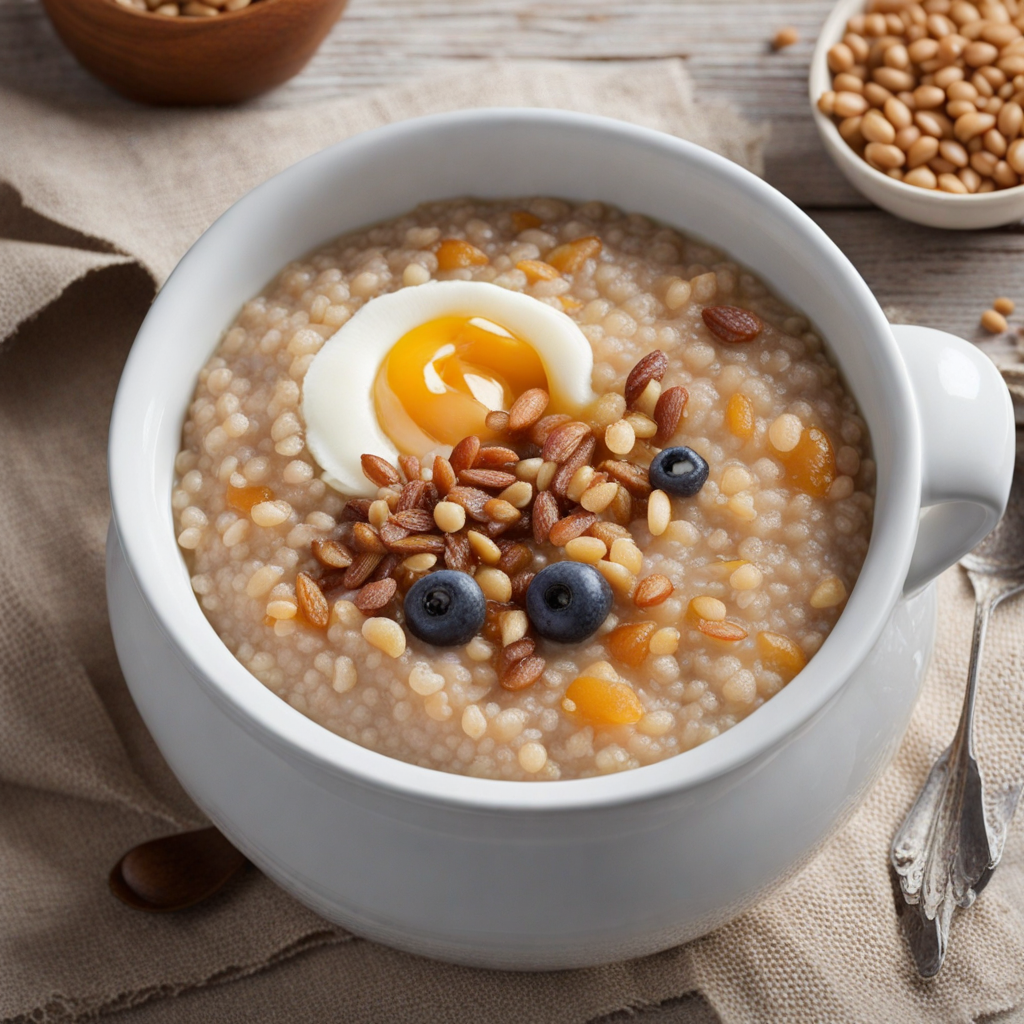Zakuski
Zakuski is a delightful array of traditional Russian appetizers that showcase the country's rich culinary heritage. Typically served cold or at room temperature, these small bites are perfect for sharing and are often enjoyed during festive gatherings or casual get-togethers. The selection of zakuski can vary greatly, but common ingredients include cured meats, pickled vegetables, herring, smoked fish, and a variety of cheeses. Each component is thoughtfully prepared to bring out its natural flavors, often accompanied by a dollop of creamy horseradish or tangy mustard for added zest. One of the most iconic dishes within the zakuski spread is the marinated herring, which is usually served with sliced onions and a sprinkle of dill. Another favorite is the assortment of pickled vegetables like cucumbers, tomatoes, and even mushrooms, which add a refreshing crunch and acidity to balance the rich flavors of meats and cheeses. Pirozhki, small filled pastries, can also make an appearance, offering a warm, comforting option amidst the cooler dishes. The variety in textures and flavors creates an engaging tasting experience that invites guests to sample a little bit of everything. Pairing zakuski with a shot of vodka is a time-honored tradition in Russia, enhancing the overall experience and encouraging lively conversation. Each bite of zakuski not only tantalizes the taste buds but also tells a story of Russian culture and communal dining. The vibrant colors and diverse flavors make zakuski not just a meal but a celebration of food that brings people together, making it a must-try for anyone looking to explore the culinary landscape of Russia.
How It Became This Dish
The History of Закуски: A Savory Tradition in Russian Cuisine Закуски (zakuski) can be translated roughly as "snacks" or "appetizers," but this term encompasses much more than mere finger foods in Russian culinary tradition. Zakuski represent a cultural practice steeped in history, social rituals, and a reflection of Russian hospitality. They are an integral part of the Russian dining experience, often served at gatherings, celebrations, and everyday meals alike. #### Origins of Закуски The roots of zakuski can be traced back to the vast and varied landscapes of Russia, where diverse ingredients and culinary practices came together. The etymology of the word "закуска" itself suggests a process of "snacking" or "nibbling," derived from the verb "закусить" (zakusit'), which means "to bite." The tradition of enjoying small dishes goes back to ancient Slavic customs, when communal meals were an essential aspect of social life. In the early days, zakuski were simple and rustic, reflecting the agricultural lifestyle of the Slavic people. Ingredients such as pickled vegetables, cured meats, and freshly baked bread formed the cornerstone of early zakuski. The preservation methods used in these dishes were crucial, as they allowed people to enjoy the bounty of the harvest long into the winter months. #### Cultural Significance Zakuski are much more than just food; they embody the spirit of Russian hospitality and communal dining. Traditionally, they are served alongside vodka, and this pairing has become iconic in Russian culture. When guests arrive, they are often welcomed with a spread of various zakuski, which encourages conviviality and conversation. The act of sharing these small dishes fosters a sense of community and warmth, making zakuski an essential element of gatherings, from family dinners to celebratory feasts. The importance of zakuski in Russian culture is also evident in their role during significant events. For example, at weddings, a lavish spread of zakuski is presented to symbolize abundance and good fortune. Similarly, during the New Year’s celebration, zakuski are a vital part of the feast, signifying the hope for a prosperous year ahead. #### Development Through the Ages The evolution of zakuski can be divided into several key historical periods, each marked by socio-political changes and culinary innovations. 1. Kievan Rus and Early Influences (9th-13th Centuries): The earliest forms of zakuski were influenced by the interactions with neighboring cultures, particularly the Byzantine Empire. The incorporation of spices and new preservation techniques from trade routes began to diversify the flavors and presentation of zakuski. 2. Mongol Invasion and the Rise of the Tsardom (13th-17th Centuries): The Mongol invasion brought about significant changes in Russian society and cuisine. Ingredients such as rice and spices from the East were introduced, enriching the zakuski repertoire. During the reign of Ivan the Terrible, lavish banquets became a way for the nobility to display their wealth, and zakuski evolved into more sophisticated dishes, often featuring elaborate garnishes and intricate presentations. 3. The Age of Enlightenment and European Influences (18th Century): The 18th century saw a growing fascination with French cuisine among the Russian aristocracy. The influence of French culinary techniques led to the refinement of zakuski, with the introduction of salads, terrines, and pâtés. This period marked the transition from simple peasant food to a more elaborate dining experience, with zakuski becoming an art form that showcased the host’s culinary prowess. 4. The Soviet Era (20th Century): The Soviet period brought about significant changes in Russian cuisine, including zakuski. With food shortages and restrictions on ingredients, creativity became key. Traditional recipes were adapted to utilize available resources, and new types of zakuski emerged, such as Olivier salad, which became a staple during festive occasions. The communal nature of zakuski persisted, as they were often shared in large groups, reflecting the social fabric of Soviet life. 5. Post-Soviet Revival and Modern Trends (Late 20th Century-Present): The collapse of the Soviet Union led to a renaissance in Russian cuisine, with chefs exploring regional ingredients and traditional recipes. Zakuski have experienced a revival, with a focus on authenticity and artisanal production. Contemporary chefs are now reinterpreting classic zakuski with a modern twist, incorporating international flavors while maintaining the spirit of traditional Russian hospitality. #### Types of Закуски Zakuski can be categorized into various types, each with its own distinct flavors and presentation styles: - Pickles and Fermented Foods: Traditional Russian zakuski often feature a variety of pickled vegetables, such as cucumbers, tomatoes, and cabbage. These not only provide a tangy contrast to richer dishes but also reflect the Russian tradition of preserving food. - Cold Cuts and Fish: Cured meats like salami, ham, and smoked fish are common zakuski. Herring under a fur coat (селедка под шубой) is a popular dish that layers herring with vegetables and mayonnaise, creating a colorful and flavorful centerpiece. - Salads: Russian salads, such as Olivier and vinaigrette, are often served as zakuski. These salads incorporate a medley of ingredients, reflecting both Russian agricultural practices and European influences. - Cheese and Bread: A selection of local cheeses and freshly baked bread is a staple of any zakuski spread. Rye bread is particularly favored, adding a robust flavor that complements the other dishes. - Hot Zakuski: While many zakuski are served cold, hot appetizers, such as meat pies (пирожки) and stuffed vegetables, also play a role in the zakuski tradition, offering variety and warmth to the meal. #### Conclusion Zakuski are more than just appetizers; they are a celebration of Russian culture, history, and community. From their humble beginnings to their current status as a symbol of hospitality and culinary artistry, zakuski have evolved while retaining their essence. Whether enjoyed at a festive gathering, a family meal, or a casual evening with friends, zakuski continue to bring people together, reflecting the rich tapestry of Russian life and cuisine. As Russia continues to explore its culinary heritage and embrace modern influences, zakuski will undoubtedly remain a beloved tradition, bridging the past and the present in every bite.
You may like
Discover local flavors from Russia


